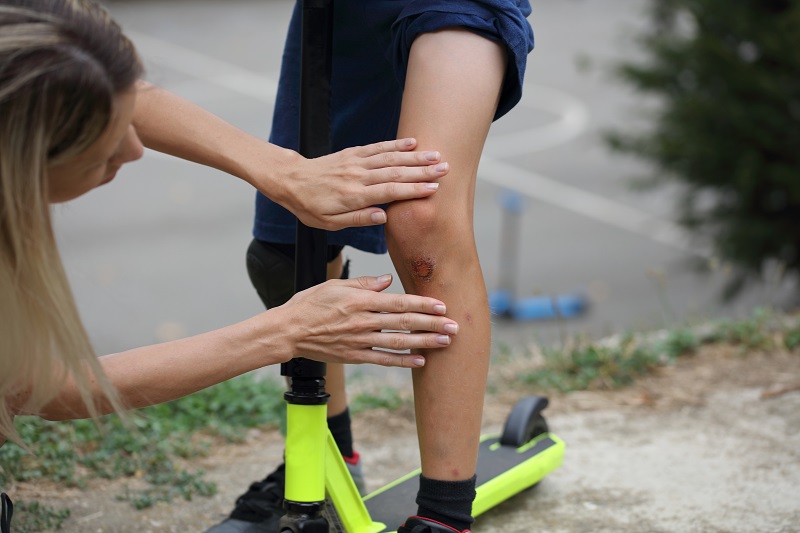Spotting Infection: How to Tell if a Cut is Infected

August 24, 2022
For most people, cuts and scrapes heal fairly quickly and easily. Without proper treatment, however, this process can become much more complicated if your cut becomes infected.
It is important to know the difference between a cut that just needs time to heal and one that has developed an infection.
What causes a cut to get infected?
When bacteria enters a cut, it can get infected. Bacteria can come from anywhere, from the ground, to dirt or your skin, there are many opportunities for your cut to get infected according to internal medicine specialist, Joseph Heaton, M.D.
Due to this, a common place for infection is your foot. From walking barefoot outside to sweating while wearing socks or shoes, a cut on your foot can easily get infected if it’s not cleaned and covered effectively. Your feet are a common place for bacterial infections as they spend much of a given day without exposure to air, which makes it harder for a cut to heal.
With any body part that gets a cut, it is important to make sure that it can get proper ventilation so that sweat does not build up. Most bandages are breathable, and can help to keep your cut protected from bacteria while it is healing.
What are the signs of an infection?
A little redness and clear or slightly yellow drainage are normal traits for your cut to have. Signs to look out for that may mean your cut is infected include:
- Increased or darkening redness
- More pus or fluid leaking out of the wound
- Pain at the site getting worse and not improving
- Red marks not only at the sit of the cut, but starting to move or spread
- Area surrounding the cut can be warm
- Feeling worn down or feverish are signs that the infection might be spreading into your body.
How do you treat an infected cut?
“The best thing you can do for an infected cut is to keep it clean and dry, for this soap and water is a great start,” says Dr. Heaton. “You can also apply an over-the-counter antibiotic cream to help treat the infection and stop the growth of bacteria, like bacitracin or neosporin. Depending on the infection, you may need a prescription oral antibiotic as well.”
The average healing time for a cut is approximately one week. However, comorbidities or other medical conditions can delay the healing process and put you at higher risk of infection. These health factors include diabetes, vitamin deficiencies and a weakened immune system. Sometimes age can be a factor as well.
Dr. Heaton recommends that if there are signs the infection is getting worse after seven to 10 days, you should seek medical attention.
How can I prevent an infection?
- Clean out your wound with soap and water immediately.
- Any dirt or outside materials that may have gotten into the cut should be removed in order for the cut to be considered fully cleansed.
- If you need to use equipment to remove something from your cut, make sure it is clean before using it on your exposed skin.
- Allow your skin to air-dry after washing. Any moisture within the cut will slow down the healing process.
- Cover the wound with the appropriate dressing.
- This will protect your cut from outside bacteria.
- Applying topical formulas can also prevent infection.
- Consider antibiotics. This may depend on the severity of your cut or the way that you got it.
- Although minor cuts and scrapes can usually heal on their own, an antibiotic cream is usually recommended for even small cuts.
- If a wound is large or the infection continues to worsen, an oral antibiotic can be used to help combat infection.
“Make sure you are up to date on your tetanus shot – these vaccines are good for 10 years. Children under the age of seven get the DTaP, for those older, you’ll get the Tdap,” adds Dr. Heaton. “These vaccines are important to help prevent infection.”
Next Steps & Resources:
- Meet our source: Joseph Heaton, M.D.
- To make an appointment with a health care provider near you, call 800-822-8905 or visit our website.
The material provided through HealthU is intended to be used as general information only and should not replace the advice of your physician. Always consult your physician for individual care.
Find a doctor near me

Sinus Infections: Your Top 5 Questions Answered
Find sinus infection answers from Dr. Winarsky. Learn about symptoms, relief, and treatment options. Get expert advice now.

Nail Biting: Is it That Bad?
Stop nail biting. Learn how this habit harms teeth, gums, and overall health. Dr. Condello offers tips to quit. Get healthy nails now.
Find a doctor near me

ER vs. Urgent Care vs. Pediatrician
When your child gets sick, it can be hard to know - should you go to the emergency room (ER), urgent care or pediatrician?

Do All Ticks Carry Lyme Disease?
Learn about Lyme disease from Joseph M. Sanzari Children’s Hospital. Dr. Baer explains tick bites, prevention, and treatment. Get expert advice now.

How to Get Rid of a UTI
Learn how to treat a UTI. Dr. Koo offers advice on UTI symptoms, home remedies, and prevention. Get relief and learn how to avoid future UTIs. Call 800-822-8905.

Monkeypox: 5 Things You Should Know
Understand Monkeypox: Learn key facts, symptoms, and prevention from leading doctors. Get the information you need to protect yourself and your family.
